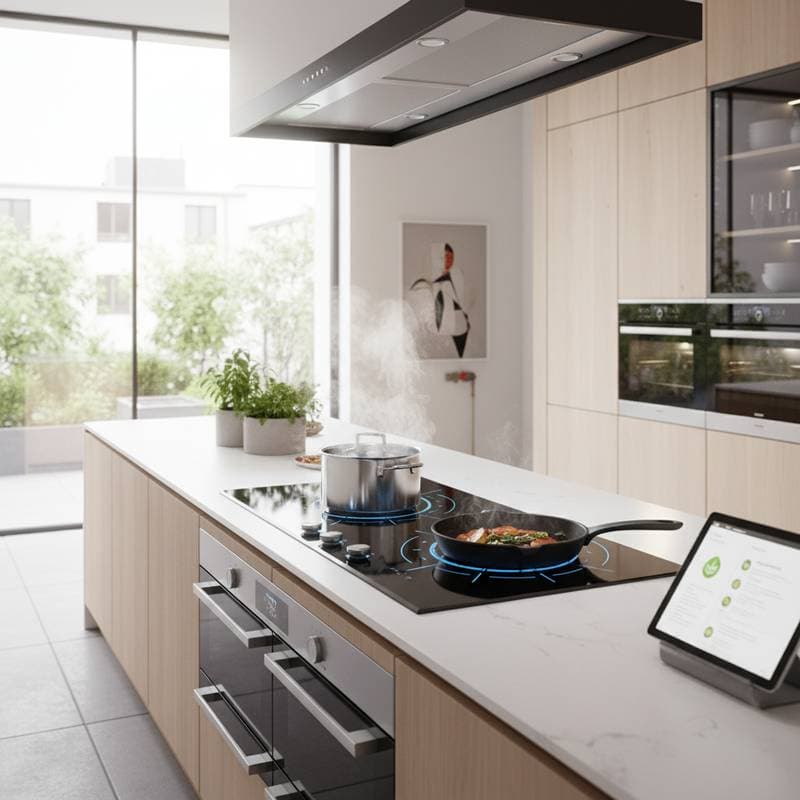Is a $3,000 Induction Cooktop Upgrade Worth It for Your Kitchen Remodel?
Homeowners undertaking a kitchen remodel often face decisions about appliances that balance innovation with budget constraints. When a contractor proposes an induction cooktop upgrade at around three thousand dollars, hesitation is understandable. The question arises: does this investment elevate daily cooking enough to justify the expense, or is a traditional gas or electric option sufficient?
Induction cooktops deliver exceptional speed and control, alongside notable energy efficiency. These advantages appeal to frequent cooks seeking modern convenience. However, the decision hinges on installation feasibility, ongoing costs, and alignment with household needs. This guide examines the components of the price, performance comparisons, and key factors to determine if the upgrade aligns with your remodel goals.
Key Features of Induction Cooktops
Induction technology employs electromagnetic fields to generate heat directly within compatible cookware. This method contrasts with gas flames or electric coils, which primarily heat the cooking surface before transferring warmth to pots. As a result, induction provides rapid response times and maintains a cooler cooktop exterior, enhancing both usability and safety.
Specific benefits include the following:
- Rapid heating: Water reaches a boil in under two minutes on high settings, surpassing gas by up to 50 percent in tests.
- Precise adjustments: Temperature shifts occur almost instantly, supporting tasks from searing steaks to gentle melting of chocolate.
- Enhanced safety: The glass surface remains below 150 degrees Fahrenheit after pan removal, reducing burn risks in busy kitchens.
- Superior efficiency: Approximately 85 percent of energy converts to heat in the cookware, minimizing waste compared to other methods.
Compatibility requires ferromagnetic cookware, such as cast iron or certain stainless steel. Kitchens without suitable pots may incur additional expenses. Professional kitchens favor induction for its reliability during high-volume service, a trait that translates well to home use.
Breaking Down the $3,000 Cost
The three-thousand-dollar figure typically encompasses the appliance and necessary modifications. Costs vary by brand, model features, and existing infrastructure. Understanding these elements helps assess value relative to alternatives.
Here is a typical allocation:
- Cooktop appliance: Mid-range models with four to five burners cost between one thousand and two thousand dollars, including touch controls and power boost functions.
- Electrical upgrades: Installation of a 240-volt, 40-amp circuit adds three hundred to eight hundred dollars, depending on wiring distance and panel access.
- Countertop adjustments: Reshaping the cutout for a seamless fit ranges from one hundred to three hundred dollars, especially when transitioning from a gas unit.
- Compatible cookware: A basic set of induction-ready pans starts at two hundred dollars; full replacements for extensive collections reach six hundred dollars.
These components accumulate quickly during a remodel. Budget-conscious homeowners benefit from obtaining multiple quotes to identify potential savings. Professional installation ensures compliance with local codes, avoiding future complications.
Induction Versus Gas and Electric Options
Selecting a cooktop involves evaluating how each type supports cooking routines and energy preferences. Gas offers visible flames for intuitive control, while electric coils provide simplicity at lower initial costs. Induction excels in metrics that matter for efficiency-focused users.
| Feature | Induction | Gas | Electric Coil |
|---|---|---|---|
| Heating speed | Fastest | Fast | Moderate |
| Temperature control | Excellent | Excellent | Fair |
| Energy efficiency | About 85% | Around 40% | About 70% |
| Safety | Very safe | Open flame | Hot surface |
| Maintenance | Easy to clean | Burner grates need scrubbing | Coil cleanup varies |
| Upfront cost | High | Moderate | Low |
Daily cooks appreciate induction's quick recovery from temperature drops, ideal for multitasking. Gas suits those who enjoy flame-based techniques, such as stir-frying. Electric coils work well in basic setups but lag in responsiveness. Local utility rates influence long-term economics; induction often yields savings in electric-heavy regions.
Navigating Installation Requirements
Successful induction integration starts with verifying electrical infrastructure. Most units demand a dedicated 240-volt line to support peak power draws of nine thousand watts or more. Homes with updated panels handle this seamlessly, limiting work to basic connections.
Older systems may require panel expansions, adding five hundred to one thousand dollars. Engage a licensed electrician for a load calculation to prevent overloads. Countertop compatibility involves measuring the unit's footprint, often 30 to 36 inches wide, against the existing opening.
Switching from gas necessitates capping the fuel line, a task reserved for certified professionals to ensure no leaks. Post-installation, test all burners for even heating. These steps, though involved, position the kitchen for reliable operation over the appliance's expected 10- to 15-year lifespan.
Long-Term Value and Efficiency Gains
Initial expenses give way to operational advantages with induction. Energy consumption drops by 20 to 30 percent compared to gas, cooling the kitchen and trimming bills by fifty to one hundred dollars annually for active users. Durability features, like scratch-resistant glass, reduce replacement frequency.
Repairs, when needed, focus on electronic components but prove infrequent with proper care. Induction aligns with broader electrification trends, boosting resale value in markets prioritizing sustainability. Homeowners report satisfaction from the seamless integration into smart-home ecosystems, enabling remote preheating.
Scenarios Where Induction Pays Off
The upgrade proves worthwhile under specific conditions. Frequent cooking demands, such as preparing family meals or baking, leverage the precision to save time. Remodels already involving countertop replacement minimize added disruption.
Electrical readiness without major overhauls keeps costs contained. Households prioritizing safety, especially with children, gain peace of mind from the cool-touch design. Energy-conscious owners in high-cost areas recoup investments faster through rebates and lower usage.
Conversely, occasional cooks or gas enthusiasts may find the outlay disproportionate. Tasks requiring direct flames, like torching crepes, favor traditional setups. Extensive electrical work signals a need to explore hybrid options or defer the change.
Steps to Implement Your Induction Upgrade
Begin by scheduling an electrician consultation to map electrical needs. Coordinate with your contractor on countertop specs to avoid mismatches. Research models from brands like Bosch or GE, prioritizing those with strong warranties and local support.
Hunt for utility incentives, which can rebate up to five hundred dollars for efficient appliances. Acquire a magnet to test existing cookware compatibility before full purchases. After setup, experiment with settings to master the responsive controls.
The result is a kitchen that responds intuitively to your routines, fostering enjoyment in every use. Induction transforms cooking from a chore into an efficient pleasure, justifying the strategic investment for discerning remodelers.










